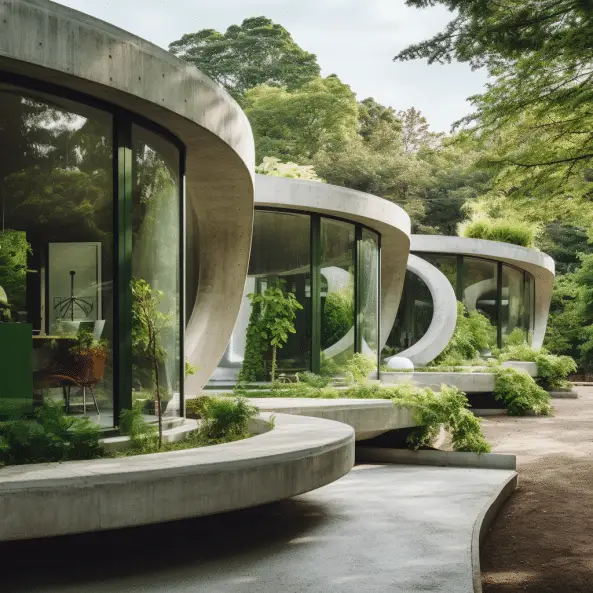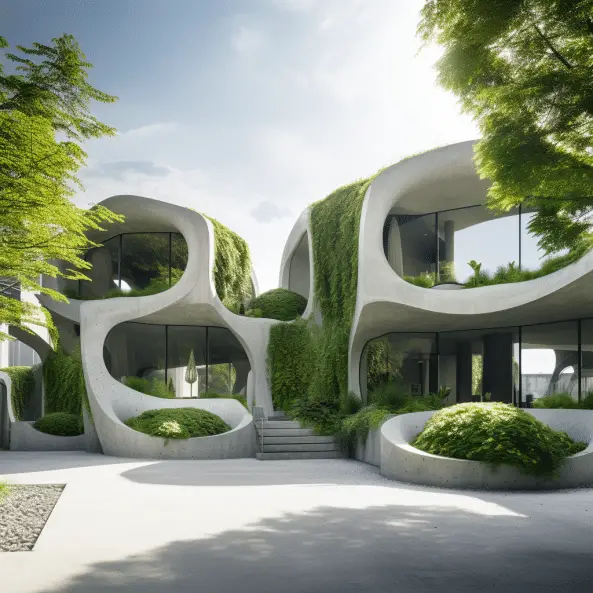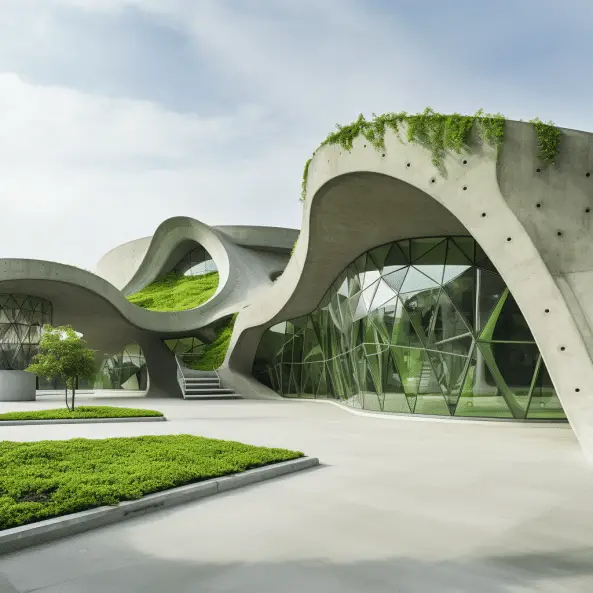Green Concrete: Sustainable Innovation for Modern Construction
Green Concrete Sustainability is an innovative solution that offers numerous benefits for modern construction. As an eco-friendly alternative to traditional concrete, it provides a sustainable approach to building that minimizes environmental impact.
Introduced in 1998, green concrete is made by utilizing industrial and non-commercial waste products, reducing carbon dioxide emissions, and consuming less energy during production. By incorporating waste materials, it not only diverts them from landfills but also reduces the need for resource-intensive raw materials.
One of the key advantages of green concrete is its reduced carbon dioxide emissions. Traditional concrete production accounts for a significant portion of global CO2 emissions, but green concrete’s use of supplementary cementitious materials and recycled aggregates helps mitigate this impact.
In addition to being eco-friendly, green concrete offers increased durability and improved energy efficiency. This makes it a smart choice for long-lasting structures that require minimal maintenance, resulting in cost savings over time.
Overall, green concrete provides a sustainable and practical solution for modern construction, combining environmental responsibility with enhanced building performance.
Key Takeaways:
- Green concrete is an eco-friendly alternative to traditional concrete.
- It utilizes waste materials and reduces carbon dioxide emissions.
- Green concrete offers increased durability and improved energy efficiency.
- It contributes to sustainable construction practices and reduces environmental impact.
- By adopting green concrete, the construction industry can promote a more sustainable future.
Understanding Sustainable Concrete
Sustainable concrete is an eco-friendly alternative to traditional concrete that aims to reduce its environmental impact. Unlike conventional concrete, which heavily relies on cement and contributes to carbon dioxide emissions, sustainable concrete incorporates environmentally responsible materials and production processes.
“Sustainable concrete is a game-changer for the construction industry. By utilizing supplementary cementitious materials, recycled aggregates, and eco-friendly admixtures, we can reduce CO2 emissions, conserve resources, and minimize waste.”
The production process of sustainable concrete focuses on optimizing resource usage and minimizing waste generation. Strategies such as replacing a portion of cement with supplementary cementitious materials and incorporating recycled aggregates help reduce environmental impact. Additionally, innovative techniques like carbon capture and storage can further mitigate CO2 emissions.
By choosing sustainable concrete, the construction industry can enjoy several benefits across environmental, economic, and social aspects. It not only reduces carbon dioxide emissions and conserves natural resources but also leads to long-term cost savings and job creation. Moreover, sustainable concrete contributes to the well-being of local communities by promoting sustainable living environments and supporting local economies.
| Benefits of Sustainable Concrete |
|---|
| Reduced carbon dioxide emissions |
| Conservation of natural resources |
| Minimized waste generation |
| Long-term cost savings |
| Job creation |
| Improved community well-being |

Components of Sustainable Concrete
When it comes to sustainable concrete, there are several key components that contribute to its eco-friendly nature. These components include supplementary cementitious materials (SCMs), recycled aggregates, and eco-friendly admixtures.
Supplementary cementitious materials (SCMs) play a crucial role in sustainable concrete. Materials such as fly ash, ground granulated blast furnace slag (GGBFS), and silica fume are used to replace a portion of the cement in the concrete mix. This not only reduces carbon dioxide emissions but also improves the overall performance and durability of the concrete.
Recycled aggregates are another important component of sustainable concrete. These aggregates are sourced from construction and demolition waste, reducing the need for extracting natural aggregates. By utilizing recycled materials, resources are conserved, and waste generation is minimized.
Eco-friendly admixtures further enhance the sustainability of concrete. These admixtures include water-reducing agents, air-entraining agents, and pozzolanic admixtures. They improve the workability, strength, and durability of the concrete while reducing the environmental impact of construction.
By incorporating these components into the production of concrete, we can create a more sustainable and environmentally friendly construction material.
Production Process of Sustainable Concrete
The production process of sustainable concrete is designed to reduce CO2 emissions, optimize resource usage, and minimize waste generation. By implementing various strategies and innovative techniques, the construction industry can contribute to a more sustainable and environmentally responsible future.
Utilizing Supplementary Cementitious Materials
One key aspect of the production process is the incorporation of supplementary cementitious materials (SCMs). SCMs, such as fly ash, ground granulated blast furnace slag (GGBFS), and silica fume, are used to replace a portion of the cement in the concrete mix. This not only reduces CO2 emissions but also improves the performance and durability of the concrete.
Using Recycled Aggregates
Another important component of sustainable concrete production is the use of recycled aggregates. These aggregates are obtained from construction and demolition waste, diverting materials from landfills and conserving natural resources. By incorporating recycled aggregates, the industry can significantly reduce the environmental impact of concrete production.
Employing Eco-Friendly Admixtures
Eco-friendly admixtures are also utilized in the production process to enhance the sustainability of concrete. Water-reducing agents, air-entraining agents, and pozzolanic admixtures are some examples of eco-friendly additives. These admixtures not only improve the workability, strength, and durability of the concrete but also contribute to the reduction of CO2 emissions and the efficient use of resources.
| Production Process Strategies | Benefits |
|---|---|
| Carbon Capture and Storage | Reduces CO2 emissions |
| Efficient Resource Use | Optimizes resource consumption |
| Local Sourcing | Promotes sustainability and reduces transportation emissions |
| Utilization of Industrial Byproducts | Reduces waste generation and environmental impact |
| Lean Manufacturing and Just-in-Time Production | Minimizes waste and improves efficiency |
| Recycling of Concrete Waste | Reduces landfill waste and conserves resources |
By implementing these strategies and techniques, the production process of sustainable concrete focuses on reducing CO2 emissions, improving resource efficiency, and minimizing waste generation. This not only contributes to a greener and more sustainable construction industry but also helps in mitigating the environmental impact of concrete production.
Benefits of Sustainable Concrete
Sustainable concrete offers numerous advantages across environmental, economic, and social aspects. It is an eco-friendly solution that not only reduces carbon dioxide emissions but also conserves natural resources, minimizes waste, and promotes resilient infrastructure. Let’s take a closer look at the specific benefits of sustainable concrete.
Environmental Benefits
Sustainable concrete plays a crucial role in reducing the environmental impact of construction. By incorporating supplementary cementitious materials (SCMs), such as fly ash and slag, sustainable concrete significantly reduces carbon dioxide emissions. Additionally, the use of recycled aggregates helps conserve natural resources and diverts waste materials from landfills. These practices contribute to the preservation of ecosystems, reducing land degradation and water pollution.
Economic Benefits
Choosing sustainable concrete brings long-term cost savings and enhances resource efficiency. The enhanced durability and reduced maintenance requirements of sustainable concrete result in lower expenses for building owners and operators. Moreover, efficient resource utilization and waste reduction strategies throughout the construction process lead to significant savings. The resilience of sustainable concrete also helps reduce the need for costly repairs and replacements, further contributing to economic benefits.
Social Benefits
Sustainable concrete has positive social impacts as well. By supporting local economies, sustainable concrete promotes job creation and stimulates economic growth. When construction projects prioritize the use of sustainable materials and practices, they create opportunities for local suppliers and workers. Additionally, the use of sustainable concrete contributes to improved community well-being by creating healthier and more sustainable living environments.
| Environmental Benefits | Economic Benefits | Social Benefits |
|---|---|---|
| – Reduced CO2 emissions | – Long-term cost savings | – Support for local economies |
| – Conservation of natural resources | – Resource efficiency | – Job creation |
| – Minimized waste | – Resilient infrastructure | – Improved community well-being |
In summary, sustainable concrete brings significant environmental, economic, and social benefits to the construction industry. Its adoption contributes to a more sustainable and environmentally responsible future by reducing carbon dioxide emissions, conserving resources, minimizing waste, and creating resilient infrastructure. The economic advantages of sustainable concrete include long-term cost savings and resource efficiency, while the social benefits encompass support for local economies, job creation, and improved community well-being.
Environmental Impact of Green Concrete
Green concrete has gained popularity as an eco-friendly alternative to traditional concrete due to its significantly lower environmental impact. In contrast to the high carbon dioxide (CO2) emissions associated with cement production, green concrete incorporates sustainable practices that contribute to the reduction of CO2 emissions, land degradation, and water pollution.
One of the key contributors to the environmental impact of conventional concrete is cement production, which accounts for around 8% of global CO2 emissions. Green concrete tackles this issue by utilizing supplementary cementitious materials (SCMs) such as fly ash, ground granulated blast furnace slag (GGBFS), and silica fume. These materials replace a portion of the cement, resulting in reduced CO2 emissions and a more sustainable production process.
Additionally, green concrete promotes the use of recycled aggregates obtained from construction and demolition waste, which helps conserve natural resources and minimizes waste generation. By diverting waste materials from landfills and incorporating them into the production process, green concrete reduces the environmental impact associated with the extraction of raw materials.
The Environmental Impact of Green Concrete
“Green concrete reduces CO2 emissions, conserves natural resources, and diverts waste materials from landfills, promoting a more sustainable and responsible approach to concrete production.”
Furthermore, the incorporation of eco-friendly admixtures in green concrete enhances its environmental sustainability. These admixtures, such as water-reducing agents and air-entraining agents, improve the workability and durability of the concrete, reducing the overall material consumption and potential waste.
Overall, green concrete demonstrates a commitment to reducing the environmental impact of the construction industry. By adopting sustainable practices, such as the use of SCMs, recycled aggregates, and eco-friendly admixtures, green concrete helps mitigate CO2 emissions, protect natural resources, and minimize waste, making it an essential solution for a more environmentally responsible future.
| Environmental Impact | Traditional Concrete | Green Concrete |
|---|---|---|
| CO2 Emissions | High | Reduced through the use of SCMs |
| Land Degradation | Contributed by extraction of raw materials | Reduced through the use of recycled aggregates |
| Water Pollution | Contributed by extraction of raw materials | Reduced through the use of recycled aggregates |
Economic Advantages of Green Concrete
Green concrete offers several economic advantages that make it an attractive choice for the construction industry. One of the key benefits is long-term cost savings. Due to its enhanced durability and reduced maintenance requirements, sustainable concrete can significantly lower the operational costs for building owners and operators. By using green concrete, they can avoid frequent repairs and replacements, resulting in substantial cost savings over time.
Another economic advantage of green concrete is its resource efficiency. The production process of sustainable concrete focuses on optimizing resource usage, which can lead to significant savings during construction. Strategies such as incorporating recycled aggregates and using eco-friendly admixtures help minimize waste and promote efficient use of materials. These practices not only contribute to cost savings but also have a positive environmental impact.
Moreover, green concrete contributes to the development of resilient infrastructure. Its improved strength and durability make it more resistant to wear and tear, reducing the need for costly repairs and replacements. By using sustainable materials and practices, the construction industry can build structures that can withstand harsh environmental conditions and sustain their functionality for a longer period of time. This resilience translates into cost savings and long-term economic benefits.
| Economic Advantages of Green Concrete |
|---|
| Long-term cost savings |
| Resource efficiency |
| Resilient infrastructure |
Overall, green concrete offers several economic advantages, including long-term cost savings, resource efficiency, and the development of resilient infrastructure. These benefits make it a viable and sustainable solution for the construction industry, aligning with the growing demand for environmentally friendly and economically viable building practices.
Social Benefits of Green Concrete
Green concrete not only offers environmental and economic advantages but also provides significant social benefits. By promoting the use of sustainable materials and practices, green concrete supports local economies and creates job opportunities. This, in turn, contributes to community well-being and fosters a sense of pride and empowerment.
Supporting local economies is a crucial aspect of green concrete. By sourcing materials from local suppliers and employing local labor, construction projects using green concrete help boost local businesses and stimulate economic growth. This localized approach leads to increased job creation and employment opportunities, benefiting individuals and communities alike.
Furthermore, the use of green concrete contributes to improved community well-being. Sustainable construction practices prioritize the creation of healthier and more sustainable living environments. Green concrete reduces the emission of harmful pollutants and improves indoor air quality, promoting the health and well-being of residents. Additionally, sustainable buildings and infrastructure have a positive impact on the overall aesthetic and livability of communities, enhancing the quality of life for residents.
Support for Local Economies
The use of green concrete in construction projects supports local economies by sourcing materials from local suppliers and employing local labor. This approach ensures that economic benefits stay within the community and contribute to local businesses’ growth and sustainability.
Job Creation
Green concrete creates job opportunities, particularly in the construction sector. The implementation of sustainable construction practices requires skilled labor, leading to increased employment in areas such as concrete production, construction, and project management. These job opportunities contribute to job market stability and economic growth.
Community Well-being
Green concrete plays a vital role in improving community well-being. Sustainable construction practices prioritize the health and comfort of residents by reducing indoor air pollution and creating more sustainable living environments. This, in turn, enhances the overall quality of life, leading to happier and healthier communities.
Overall, green concrete’s social benefits extend beyond its environmental and economic advantages. By supporting local economies, creating job opportunities, and improving community well-being, green concrete contributes to a more sustainable and prosperous future for individuals and communities alike.

Conclusion
In conclusion, green concrete is a sustainable and eco-friendly solution that offers a wide range of benefits for the construction industry. It not only reduces carbon dioxide emissions, but also conserves natural resources and minimizes waste. By incorporating green concrete into construction projects, we can contribute to a more sustainable and environmentally responsible future.
One of the key advantages of green concrete is its long-term cost savings and resource efficiency. With enhanced durability and reduced maintenance requirements, building owners can save significant costs over time. Additionally, the use of sustainable materials and practices promotes local economies and job creation, leading to improved community well-being.
Furthermore, green concrete contributes to the development of resilient infrastructure. Its improved strength and durability reduce the need for costly repairs and replacements, ensuring long-lasting structures. By adopting green concrete, we can create healthier and more sustainable living environments for future generations.
In summary, the benefits of green concrete are evident in its ability to reduce CO2 emissions, support sustainable construction practices, and provide an eco-friendly solution. By embracing green concrete, we can pave the way for a more sustainable and responsible construction industry.
FAQ
What is green concrete?
Green concrete is an innovative and eco-friendly alternative to traditional concrete that was invented in 1998. It is made by utilizing industrial and non-commercial waste products, reducing carbon dioxide emissions, and consuming less energy during production.
What are the benefits of green concrete?
Green concrete offers several benefits, including the utilization of waste materials, reduced carbon dioxide emissions, increased durability, and improved energy efficiency. It also conserves natural resources, minimizes waste, and promotes resilient infrastructure.
How is sustainable concrete produced?
Sustainable concrete is produced by incorporating supplementary cementitious materials (SCMs), such as fly ash and ground granulated blast furnace slag, using recycled aggregates, and employing eco-friendly admixtures. These materials and processes help reduce CO2 emissions, conserve natural resources, and minimize waste.
What are the environmental benefits of sustainable concrete?
Sustainable concrete reduces CO2 emissions, conserves natural resources, minimizes waste, and helps reduce land degradation and water pollution. It promotes a more sustainable and responsible construction industry.
What are the economic advantages of green concrete?
Green concrete offers long-term cost savings, resource efficiency, and resilient infrastructure. Its enhanced durability and reduced maintenance requirements lead to significant savings for building owners and operators throughout the construction process.
How does green concrete provide social benefits?
Green concrete supports local economies, creates job opportunities, and improves community well-being. The use of sustainable materials and practices in construction projects promotes economic growth and creates healthier and more sustainable living environments.
What is the environmental impact of traditional concrete?
Traditional concrete production contributes to approximately 8% of global CO2 emissions and leads to land degradation and water pollution due to the extraction of raw materials. Green concrete mitigates these negative consequences by reducing CO2 emissions, conserving resources, and diverting waste materials from landfills.
How does green concrete offer economic advantages?
Green concrete provides long-term cost savings, resource efficiency, and reduced maintenance requirements. Its improved strength and durability result in fewer repairs and replacements, further contributing to economic benefits.
How does green concrete contribute to social well-being?
Green concrete supports local economies by stimulating economic growth and creating job opportunities. It also improves community well-being by creating healthier and more sustainable living environments.








